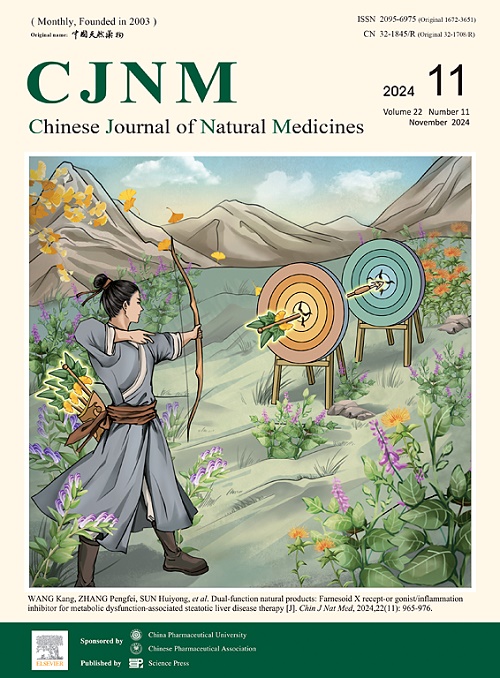Dual-function natural products: Farnesoid X receptor agonist/inflammation inhibitor for metabolic dysfunction-associated steatotic liver disease therapy
IF 4
2区 医学
Q1 INTEGRATIVE & COMPLEMENTARY MEDICINE
引用次数: 0
Abstract
Metabolic dysfunction-associated steatotic liver disease (MASLD) is the most prevalent chronic liver disease globally, with only one Food and Drug Administration (FDA)-approved drug for its treatment. Given MASLD’s complex pathophysiology, therapies that simultaneously target multiple pathways are highly desirable. One promising approach is dual-modulation of the farnesoid X receptor (FXR), which regulates lipid and bile acid metabolism. However, FXR agonists alone are insufficient due to their limited anti-inflammatory effects. This study aimed to dto identify natural products capable of both FXR activation and inflammation inhibition to provide a comprehensive therapeutic approach for MASLD. Potential FXR ligands from the Natural Product Library were predicted via virtual screening using the Protein Preparation Wizard module in Schrodinger (2018) for molecular docking. Direct binding and regulation of candidate compounds on FXR were analyzed using surface plasmon resonance (SPR) binding assay, reporter gene analysis, and reverse transcription-polymerase chain reaction (RT-PCR). The anti-inflammatory properties of these compounds were evaluated in AML12 cells treated with tumor necrosis factor-alpha (TNF-α). Dual-function compounds with FXR agonism and inflammation inhibition were further identified in cells transfected with Fxr siRNA and treated with TNF-α. The effects of these dual-function compounds on lipid accumulation and inflammation were evaluated in cells treated with palmitic acid. Results revealed that 17 natural products were predicted via computational molecular docking as potential FXR agonists, with 15 exhibiting a strong affinity for FXR recombinant protein. Nine isoflavone compounds significantly enhanced FXR reporter luciferase activity and the mRNA expressions of Shp and Ostb. Structure-activity relationship analysis indicated that introducing isopropyl or methoxy groups at the C7 position or a methoxy group at the C6 position could enhance the agonistic efficacy of isoflavones. Three compounds (2, 6, and 8) were identified as dual-function natural products functioning as FXR agonists and inflammatory inhibitors, while one compound (12) acted as an FXR agonist to inhibit inflammation. These natural products protected hepatocytes against palmitic acid-induced lipid accumulation and inflammation. In conclusion, compounds 2, 6, and 8 (genistein, biochanin A, and 7-methoxyisoflavone, respectively) were identified as dual-function bioactive products that transactivate FXR and inhibit inflammation, serving as potential candidates or lead compounds for MASLD therapy.
双功能天然产品:用于治疗代谢功能障碍相关脂肪性肝病的类脂质 X 受体激动剂/炎症抑制剂
代谢功能障碍相关性脂肪性肝病(MASLD)是全球发病率最高的慢性肝病,目前仅有一种治疗该病的药物获得了美国食品和药物管理局(FDA)的批准。鉴于代谢性脂肪肝的病理生理学十分复杂,同时针对多种途径的疗法非常可取。一种很有前景的方法是对调节脂质和胆汁酸代谢的法尼类固醇 X 受体(FXR)进行双重调节。然而,由于 FXR 激动剂的抗炎作用有限,因此仅使用 FXR 激动剂是不够的。本研究旨在找出既能激活 FXR 又能抑制炎症的天然产物,为 MASLD 提供一种综合治疗方法。利用 Schrodinger (2018) 中的蛋白质制备向导模块进行分子对接,通过虚拟筛选预测了天然产物库中潜在的 FXR 配体。利用表面等离子体共振(SPR)结合试验、报告基因分析和反转录聚合酶链反应(RT-PCR)分析了候选化合物与FXR的直接结合和调控。在肿瘤坏死因子-α(TNF-α)处理的 AML12 细胞中评估了这些化合物的抗炎特性。在转染 Fxr siRNA 并用 TNF-α 处理的细胞中,进一步鉴定了具有 FXR 激动和炎症抑制作用的双功能化合物。在用棕榈酸处理的细胞中评估了这些双功能化合物对脂质积累和炎症的影响。结果显示,通过计算分子对接,有 17 种天然产品被预测为潜在的 FXR 激动剂,其中 15 种与 FXR 重组蛋白有很强的亲和力。9种异黄酮化合物显著增强了FXR报告荧光素酶活性以及Shp和Ostb的mRNA表达。结构-活性关系分析表明,在 C7 位引入异丙基或甲氧基或在 C6 位引入甲氧基可增强异黄酮的激动效能。三个化合物(2、6 和 8)被鉴定为具有 FXR 激动剂和炎症抑制剂双重功能的天然产物,而一个化合物(12)则作为 FXR 激动剂抑制炎症。这些天然产物保护肝细胞免受棕榈酸诱导的脂质积累和炎症的影响。总之,化合物 2、6 和 8(分别为染料木素、生物茶素 A 和 7-甲氧基异黄酮)被鉴定为具有双重功能的生物活性产物,它们既能反式激活 FXR,又能抑制炎症,是 MASLD 治疗的潜在候选化合物或先导化合物。
本文章由计算机程序翻译,如有差异,请以英文原文为准。
求助全文
约1分钟内获得全文
求助全文
来源期刊

Chinese Journal of Natural Medicines
INTEGRATIVE & COMPLEMENTARY MEDICINE-PHARMACOLOGY & PHARMACY
CiteScore
7.50
自引率
4.30%
发文量
2235
期刊介绍:
The Chinese Journal of Natural Medicines (CJNM), founded and sponsored in May 2003 by China Pharmaceutical University and the Chinese Pharmaceutical Association, is devoted to communication among pharmaceutical and medical scientists interested in the advancement of Traditional Chinese Medicines (TCM). CJNM publishes articles relating to a broad spectrum of bioactive natural products, leading compounds and medicines derived from Traditional Chinese Medicines (TCM).
Topics covered by the journal are: Resources of Traditional Chinese Medicines; Interaction and complexity of prescription; Natural Products Chemistry (including structure modification, semi-and total synthesis, bio-transformation); Pharmacology of natural products and prescription (including pharmacokinetics and toxicology); Pharmaceutics and Analytical Methods of natural products.
 求助内容:
求助内容: 应助结果提醒方式:
应助结果提醒方式:


